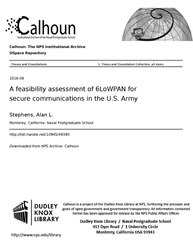File:A feasibility assessment of 6LoWPAN for secure communications in the U.S. Army (IA afeasibilitysses1094549390).pdf

Original file (1,275 × 1,650 pixels, file size: 1.49 MB, MIME type: application/pdf, 88 pages)
Captions
Captions
Summary[edit]
| A feasibility assessment of 6LoWPAN for secure communications in the U.S. Army
( |
||
|---|---|---|
| Author |
Stephens, Alan L. |
|
| Title |
A feasibility assessment of 6LoWPAN for secure communications in the U.S. Army |
|
| Publisher |
Monterey, California: Naval Postgraduate School |
|
| Description |
This thesis uses systems engineering techniques to assess the feasibility for the United States Army to use IPv6 securely over an IEEE standard 802.15.4 (6LoWPAN) network in both an operational and a support role. The methods used include assessing the limitations and security mechanisms of 6LoWPAN, assessing wireless security concerns, small battery capacity and duration, and the remaining potential for use in both environments. The same model could apply to other protocols or capabilities given operational requirements. Expected operational situations aid in identification of requirements. The two operational scenarios examined in this thesis indicate 6LoWPAN could provide value and meet technical requirements in a support environment such as a combat hospital, but analysis of a tactical situation such as replacing an AN/PRC-154A radio for Nett Warrior backhaul indicates its implementation would be problematic. Specifically, in the generalized tactical role, 6LoWPAN devices with a standard AAA rechargeable battery exhibit a lifetime of 11.7 hours or 15.3 hours with a standard AA rechargeable battery and 2.45-inch device length transmitting at -2 dBm. The required encryption standards and layered protocol stack headers result in message payload limits, the worst-case being 45 bytes of data. Reliable voice communications are not feasible over 6LoWPAN's limited bandwidth. Subjects: LoWPAN; 6LoWPAN; 802.15.4; energy; security; feasibility; wireless; networks; range; duration; wireless security; BFT; systems engineering; requirements; Army |
|
| Language | English | |
| Publication date | June 2016 | |
| Current location |
IA Collections: navalpostgraduateschoollibrary; fedlink |
|
| Accession number |
afeasibilitysses1094549390 |
|
| Source | ||
| Permission (Reusing this file) |
This publication is a work of the U.S. Government as defined in Title 17, United States Code, Section 101. Copyright protection is not available for this work in the United States. | |
Licensing[edit]
| Public domainPublic domainfalsefalse |
This work is in the public domain in the United States because it is a work prepared by an officer or employee of the United States Government as part of that person’s official duties under the terms of Title 17, Chapter 1, Section 105 of the US Code.
Note: This only applies to original works of the Federal Government and not to the work of any individual U.S. state, territory, commonwealth, county, municipality, or any other subdivision. This template also does not apply to postage stamp designs published by the United States Postal Service since 1978. (See § 313.6(C)(1) of Compendium of U.S. Copyright Office Practices). It also does not apply to certain US coins; see The US Mint Terms of Use.
|
 | |
| This file has been identified as being free of known restrictions under copyright law, including all related and neighboring rights. | ||
https://creativecommons.org/publicdomain/mark/1.0/PDMCreative Commons Public Domain Mark 1.0falsefalse
File history
Click on a date/time to view the file as it appeared at that time.
| Date/Time | Thumbnail | Dimensions | User | Comment | |
|---|---|---|---|---|---|
| current | 01:28, 14 July 2020 |  | 1,275 × 1,650, 88 pages (1.49 MB) | Fæ (talk | contribs) | FEDLINK - United States Federal Collection afeasibilitysses1094549390 (User talk:Fæ/IA books#Fork8) (batch 1993-2020 #5675) |
You cannot overwrite this file.
File usage on Commons
The following page uses this file:
Metadata
This file contains additional information such as Exif metadata which may have been added by the digital camera, scanner, or software program used to create or digitize it. If the file has been modified from its original state, some details such as the timestamp may not fully reflect those of the original file. The timestamp is only as accurate as the clock in the camera, and it may be completely wrong.
| Author | sjhawtho |
|---|---|
| Short title |
|
| Date and time of digitizing | 03:47, 27 May 2016 |
| Software used | PScript5.dll Version 5.2.2 |
| File change date and time | 05:29, 8 July 2016 |
| Date metadata was last modified | 05:29, 8 July 2016 |
| Conversion program | Acrobat Distiller 11.0 (Windows) |
| Encrypted | no |
| Page size | 612 x 792 pts (letter) |
| Version of PDF format | 1.4 |

